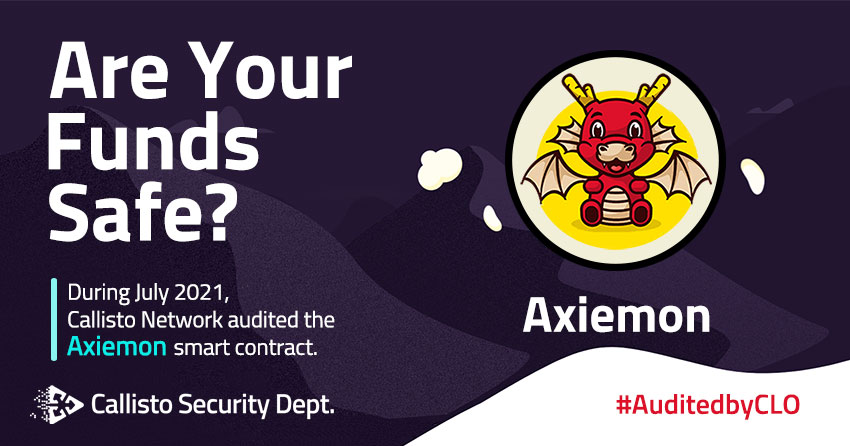Axiemon Token security audit, conducted by the Callisto Network Security Department during July 2021.
Axiemon Token Security Audit Report
Are Your Funds Safe?
Audit Request
- Twitter: https://twitter.com/axiemon
- Telegram: https://t.me/AxiemonAnn
- Community: https://t.me/Axiemonio
- Youtube: https://www.youtube.com/channel/UC0z4B3AjWIpHt8jsyLym6Xw
- Facebook: https://www.facebook.com/Axiemon/
- Instagram: https://www.instagram.com/axiemonio/
- Reddit: https://www.reddit.com/user/Axiemon
Source code
https://bscscan.com/address/0xC512261b8AE70260447A74aC7d94dAee150B90C0#code
Disclosure policy
Platform
BSC.
1. In scope
2. Findings
In total, 1 issue were reported including:
- 0 high severity issue.
- 0 medium severity issue.
- 1 low severity issue.
In total, 9 notes were reported, including:
- 3 notes.
- 6 owner privilege.
2.1 Possible incorrect message in require function.
Severity: note.
Description:
In the line 466 require(now > _lockTime , "Contract is locked until 7 days"); the message indicates a specific locking period, but function function lock() (line 456) allow to lock to any period.
Recommendation:
Replace with message without specific locking period.
2.2 No excluded accounts – unused code.
Severity: note.
Description:
The variables in lines 701-702 is declared but never initialized and there are no functions to initialize them.
mapping (address => bool) private _isExcluded;
address[] private _excluded;
Therefore contract could not have excluded from rewards addresses, and numbers of functions and its part are unused:
-
- Part of code in function
balanceOf(line 791) - Function
isExcludedFromReward(lines 825-827) - Part of code in function
deliver(line 835) - Part of code in function
_takeLiquidity(lines 951-952) - Part of code in function
_tokenTransfer(lines 1101-1109) - Function
_transferToExcluded(lines 1126-1144) - Function
_transferFromExcluded(lines 1136-1144) - Function
_transferBothExcluded(lines 860-869) - Part of code in function
_getCurrentSupply(lines 938-943).
Recommendation:
To increase readability and reduce deployment cost the unused code should be removed.
2.3 ERC20 Complines – transfer 0 value should be allowed
Severity: low.
Description:
Due ERC20 standard:
Transfers of 0 values MUST be treated as normal transfers and fire the Transfer event.Recommendation:
Remove
require(amount > 0, "Transfer amount must be greater than zero");(line 1001).2.4 Unused variable
mintedByDxsaleSeverity: note.
Description:
The variable
mintedByDxsale(line 708) was declared but never used.Recommendation:
To increase readability and reduce deployment cost the unused code should be removed.
2.5 Owner privileges
Severity: owner privileges.
Description:
Contract owner has right to:
- Exclude/include any account from/in fee, using functions
excludeFromFee(lines 871-873) andincludeInFee(lines 875-877). - Change tax fee in range from 0 to
maxTaxFeepercent, using functionsetTaxFeePercent(lines 879-878). - Change liquidity fee in range from 0 to
maxLiqFeepercent, using functionsetLiquidityFeePercent(lines 884-887). - Change maximal amount per transaction in range from
minMxTxPercentageto 100 percent of total supply, using functionsetMaxTxPercent(lines 889-894). - Enable or disable adding liquidity to pool, using function
setSwapAndLiquifyEnabled(lines 896-899). - Enable or disable all fees and transaction amount limit, using functions
disableFees(lines 1146-1154) andenableFees(lines 1156-1161).
3. Security practice
- Open-source contact.
- The contract should pass a bug bounty after the completion of the security audit.
- Public testing.
- Automated anomaly detection systems. – NOT IMPLEMENTED. A simple anomaly detection algorithm is recommended to be implemented to detect behavior that is atypical compared to normal for this contract. For instance, the contract must halt deposits in case a large amount is being withdrawn in a short period of time until the owner or the community of the contract approves further operations.
- Multisig owner account.
- Standard ERC20-related issues. – NOT IMPLEMENTED. It is known that every contract can potentially receive an unintended ERC20-token deposit without the ability to reject it even if the contract is not intended to receive or hold tokens. As a result, it is recommended to implement a function that will allow extracting any arbitrary number of tokens from the contract.
- Crosschain address collisions. ETH, ETC, CLO, etc. It is possible that a transaction can be sent to the address of your contract at another chain (as a result of a user mistake or some software fault). It is recommended that you deploy a “mock contract” that would allow you to withdraw any tokens from that address or prevent any funds deposits. Note that you can reject transactions of native token deposited, but you can not reject the deposits of ERC20 tokens. You can use this source code as a mock contract: extractor contract source code. The address of a new contract deployed using
CREATE (0xf0)opcode is assigned following this schemekeccak256(rlp([sender, nonce])). Therefore you need to use the same address that was originally used at the main chain to deploy the mock contract at a transaction with thenoncethat matches that on the original chain. Example: If you have deployed your main contract with address 0x010101 at your 2021th transaction then you need to increase your nonce of 0x010101 address to 2020 at the chain where your mock contract will be deployed. Then you can deploy your mock contract with your 2021th transaction, and it will receive the same address as your mainnet contract.
- Part of code in function
4. Conclusion
The audited smart contract can be deployed. Only low severity issues were found during the audit.
It is recommended to adhere to the security practices described in pt. 4 of this report to ensure the contract’s operability and prevent any issues that are not directly related to the code of this smart contract.
Appendix
Smart Contract Audits by Callisto Network.
Miscellaneous
Our Most Popular Audit Reports.
Trust the Blockchain, Audit the Smart Contracts.
Follow Callisto’s Security Department on Twitter to get our latest news and updates!

